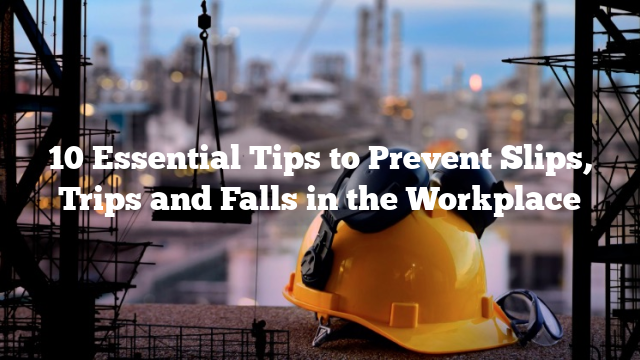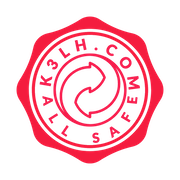Introduction:
Slips, trips, and falls are the most common workplace accidents that can occur in any industry. These accidents can cause serious injuries, lost work time, and even fatalities. According to the Occupational Safety and Health Administration (OSHA), slips, trips, and falls account for 15% of all accidental deaths in the workplace. Therefore, it is essential to implement proper measures to prevent these accidents from happening. In this blog post, we will discuss workplace slips, trips, and falls prevention and provide you with some tips to ensure your safety.
What is Workplace Slips, Trips, and Falls Prevention?
Workplace slips, trips, and falls prevention is a set of measures and procedures that aim to reduce the risk of accidents caused by slips, trips, and falls in the workplace. These measures include identifying and eliminating hazards, providing proper training to employees, and ensuring that the workplace is clean and well-maintained. The goal of workplace slips, trips, and falls prevention is to create a safe working environment and reduce the number of accidents that occur in the workplace.
Why is Workplace Slips, Trips, and Falls Prevention Important?
Workplace slips, trips, and falls prevention is crucial because it can save lives, reduce injuries, and minimize the financial impact on businesses. According to OSHA, the direct cost of slips, trips, and falls in the workplace is approximately $6 billion annually. This cost includes workers’ compensation, medical expenses, and legal fees. The indirect costs, such as lost productivity and employee morale, can be even higher. By implementing proper workplace slips, trips, and falls prevention measures, businesses can save money and improve their employees’ safety and well-being.
Facts about Workplace Slips, Trips, and Falls Prevention:
– Slips, trips, and falls are the third leading cause of workplace injuries.
– 85% of workers’ compensation claims are due to slips, trips, and falls.
– In 2019, there were 880 fatal falls in the workplace.
– The most common causes of slips, trips, and falls are wet or slippery floors, uneven surfaces, and cluttered work areas.
Tutorial of Workplace Slips, Trips, and Falls Prevention:
Identifying and eliminating hazards is the first step in workplace slips, trips, and falls prevention. Here are some tips to help you identify and eliminate hazards in your workplace:
1. Conduct a workplace safety audit: A safety audit can help you identify potential hazards in your workplace. During the audit, you should look for wet or slippery floors, uneven surfaces, cluttered work areas, and other hazards that could cause slips, trips, and falls.
2. Provide proper lighting: Adequate lighting can help employees see potential hazards and avoid accidents. Make sure that all work areas are well-lit, and replace any burnt-out light bulbs immediately.
3. Keep floors clean and dry: Wet or slippery floors can cause slips and falls. Make sure that spills are cleaned up immediately, and use caution signs to alert employees to wet floors.
4. Use slip-resistant materials: Use slip-resistant mats, flooring, and footwear to reduce the risk of slips and falls.
5. Clear cluttered work areas: Keep work areas clean and clutter-free to reduce the risk of trips and falls.
Tips of Workplace Slips, Trips, and Falls Prevention:
Here are some additional tips to help you prevent slips, trips, and falls in your workplace:
1. Wear proper footwear: Employees should wear slip-resistant shoes with good traction to reduce the risk of slips and falls.
2. Use handrails: Make sure that all stairways have handrails, and encourage employees to use them when going up or down the stairs.
3. Provide proper training: Train employees on how to identify and avoid hazards in the workplace. Make sure that all new employees receive proper training before starting work.
4. Encourage reporting: Encourage employees to report any hazards they identify in the workplace. Prompt reporting can help prevent accidents from occurring.
Question and Answer of Workplace Slips, Trips, and Falls Prevention:
1. What are the most common causes of slips, trips, and falls in the workplace?
The most common causes of slips, trips, and falls in the workplace are wet or slippery floors, uneven surfaces, and cluttered work areas.
2. How can employers prevent slips, trips, and falls in the workplace?
Employers can prevent slips, trips, and falls by identifying and eliminating hazards, providing proper training to employees, and ensuring that the workplace is clean and well-maintained.
3. What should employees do to prevent slips, trips, and falls in the workplace?
Employees can prevent slips, trips, and falls by wearing slip-resistant shoes, using handrails, and reporting any hazards they identify in the workplace.
4. Why is workplace slips, trips, and falls prevention important?
Workplace slips, trips, and falls prevention is important because it can save lives, reduce injuries, and minimize the financial impact on businesses.
Conclusion of Workplace Slips, Trips, and Falls Prevention:
Workplace slips, trips, and falls are common accidents that can cause serious injuries and financial losses. However, these accidents are preventable by implementing proper workplace slips, trips, and falls prevention measures. By identifying and eliminating hazards, providing proper training to employees, and ensuring that the workplace is clean and well-maintained, businesses can create a safe working environment and reduce the risk of slips, trips, and falls. Remember, workplace safety is everyone’s responsibility.
Recommendations:
- Osha Safety Meeting Topics Oshas safety and health topics pages provide regulatory and enforcement information hazard identification and controls as well as best practices and other resources to assist employers workers and safety and…
- Workplace Osha Safety Signs Can all be important to safety. Workplace safety signs or industrial warning signs address a variety of problems by informing workers and visitors of potential dangers. Osha Signs Workplace Signs…
- Safety Topics Slips Trips And Falls Slips trips and falls is the number 1 reason for an industrial injury in the united states. Preventing slips trips falls safety talk meeting outline follow up on any outstanding…
- Safety Inspection Report Example Page 1 of 3. Formal inspections can take different forms and you and your representatives will need to agree the best methods for your workplace. Safety Report Templates 16 Pdf…
- Workplace Safety Signs And Symbols, Why so important? Proper workplace safety signs and symbols always place in a construction site, mining site, oil and gas site or hospital and your workplace.
- Workplace Health And Safety Representative Poster Health and safety representatives information for elected health and safety representatives hsrs. But reminders posted in your workplace andor community can help. Effective Health And Safety Committees Infographic One of…
- Safety Quotes For Workplace Display them around your workplace or add them to internal newsletters. Find the best catchy competition winning heath and safety slogans and safety messages for your workplace 2020 quotable quote.…
- Health And Safety Logos Think of how nbc uses the peacock and how fex ex uses the arrow in their logo. Hazard pictograms alert us to the presence of a hazardous chemical. 3 Design…
- Osha Logo Image If you're searching for osha logo image images information related to the osha logo image interest, you have pay a visit to the right blog. Our site frequently provides you…
- 10 Effective Measures to Prevent Workplace Slips,… Workplace Slips Trips and Falls Prevention: Keeping Your Workplace Safe Workplace safety is an essential aspect of any business operation. Many accidents can occur in the workplace, but slips, trips,…
- 10 Essential Tips for Preventing Workplace Slips,… Introduction As an employee, you expect to feel safe and secure when you go to work. Unfortunately, the reality is that slips, trips, and falls are some of the most…
- Health And Safety Poster Uk Health and safety posters. Free health and safety posters. Health And Safety Law What You Need To Know Hse Law Poster A2 The health and safety executive has produced a…
- Safety Precautions Meaning Safety precautions meaning are measures taken to prevent or reduce the risk of accidents, injuries, illnesses, or damages in various settings and situations. Safety precautions are essential for protecting workers,…
- Health And Safety Law Poster Free Pdf Download 2 let you know who is responsible for making this happen. The reason that these posters are free is that this still accounts for a vast majority of workplace injuries.…
- 5 Essential Tips for Preventing Workplace Slips,… Introduction Slips, trips, and falls are the leading causes of workplace accidents and injuries. Whether you work in an office or a factory, the risk of slipping, tripping, and falling…
- Hazard And Risk Images If you're searching for hazard and risk images images information linked to the hazard and risk images keyword, you have come to the ideal site. Our site frequently gives you…
- Workplace Health And Safety Posters Hand washing posters useful hand washing posters with catchy messages to give a friendly reminder to your employees. Its the law poster available for free from osha informs workers of…
- OSHA Safety Signs All free no need to log in. If you find identical signs cheaper well match the price. Amazon Com Headline Sign Osha Safety Signs Danger No The lowest prices online.…
- Safety Quotes For The Workplace Display them around your workplace or add them to internal newsletters. Apr 25 2019 explore sotorioss board safety quotes for workplace on pinterest. Safety Quotes For The Workplace Safety In…
- 10 Tips to Prevent Workplace Slips, Trips, and Falls Introduction: Slips, trips, and falls are among the most common workplace accidents. They can happen anywhere, anytime, and to anyone. These accidents can cause serious injuries, and in some cases,…
- Osha Safety Topics Toolbox talks are an easy way for foremen and supervisors to supplement the osha training efforts of their company or organization and to keep safety front and center in their…
- Health And Safety Site Inspection Template Where a health and safety representative has drawn your attention to the findings of an inspection they have. Health and safety annual audit action plan. Form 007 Hse Weekly Inspection…
- How to Prevent Workplace Slips, Trips, and Falls: A… Workplace Slips, Trips, and Falls Prevention: How to Keep Your Employees Safe Slips, trips, and falls are some of the most common accidents that happen in workplaces. According to the…
- Safety Signs And Symbols Mar 26 2019 explore shortonecoms board safety signs and symbols on pinterest. The author of this article claims no responsibility to any accidents that happen in the laboratory. Safety Signage…
- Get PPE Easily with a PPE Vending Machine PPE Vending Machine. Personal Protective Equipment (PPE) is an essential component for the safety of many individuals. It provides the necessary protection to ensure that employees and individuals are safe…
- Health And Safety Inspection Report Template Use for office health and safety audits. Add a badge to your website or intranet so your workers can quickly find answers to their health and safety questions. Safety Report…
- Occupational Safety Logo Looking for free vectors of health and safety. The institution of occupational safety and health iosh is a british organisation for health and safety professionals. Occupational Safety And Health Logo…
- Health And Safety Topics For Meetings Choosing the right eye protection. Staying within the limits of an extended. Coping With Stress At Home Bheema Office Safety Safety Posters The following article lists some relevant safety topics…
- 10 Tips for Preventing Workplace Slips, Trips, and Falls Introduction: Slips, trips, and falls are the most common cause of workplace injuries, leading to a significant number of fatalities and injuries each year. These accidents can happen in any…
- Health And Safety Law Poster A3 Free Download The reason that these posters are free is that this still accounts for a vast majority of workplace injuries. New hse law poster from 2014 download free leaflets and pocket…
Advertisement
Scroll to Continue With Content




